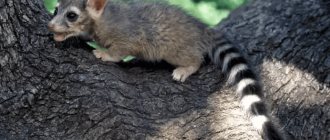The iguana, like the chameleon, is considered the most common domestic lizard. It is started by lovers of exotic animals who are not impressed by traditional pets - cats and dogs.
An iguana is a simple, beautiful reptile that is pleasing to the eye; it does not catch any insects, as a chameleon does, and therefore is not useful. The iguana has its own habits, but what does this animal eat? Where does it live, how should you care for your pet at home, and is it dangerous? Read about it below.
What does an iguana look like?
- An iguana is a large lizard. The animal's body length is approximately 2 m. Average weight is 7 kg. But in nature you can find much smaller representatives of this species, for example, the blue iguana. The lizard is covered with spines, its body length is no more than 30 cm.
Blue
- The iguana, like other lizards, is covered with scales. The scales themselves, depending on the type of reptile, can be of different sizes and colors.
- The animal has the ability to change its own color, but does not do it as easily as a chameleon. The shade of a pet depends on the temperature at which it lives. If the environment is cool, the reptile's skin becomes dark, but if it is hot, it becomes bright.
- Various species of lizards have their own colors. Typically, an iguana's color is designed to help it blend in with its surroundings as much as possible. For example, the iguana that lives in the jungle is green.
- A characteristic feature of the iguana is that it has a spiny crest located on its spine. This comb decorates the pet's appearance and also protects it.
- The iguana has a thin spine, a fairly flexible body, which is flattened on the sides. It is thanks to this structure that the animal quickly climbs even in narrow crevices.
- The lizard has a large tail , which is much larger than the body. It is muscular and helps the reptile while moving. If something threatens the iguana, it casts off its own tail, which grows back after a while.
- The iguana's paws have sharp claws. They are necessary for self-defense. With their help, the animal can also move along various uneven surfaces and climb trees, if necessary.
Exotic
- The lizard's teeth resemble human teeth in structure and can also regenerate if they fall out.
- The iguana's tongue distinguishes tastes and aromas. Sometimes it replaces the nose. Therefore, the reptile has an excellent sense of smell and navigates the world of aromas.
- The iguana's eyes see even when closed. This is because the lower eyelids have a special depression that prevents the eyes from closing 100%. That is, the lizard is physically unable to close its eyes completely. This eye structure sometimes helps the iguana during self-defense.
Reproduction
Iguanas reach sexual maturity in the second or third year of life. During the mating season, which lasts, depending on the species, either in the fall or in January-February, males begin an active search for females for mating. They search for them mainly by smell. When several males lay claim to one female, fierce fights break out between them, during which the males enthusiastically beat each other with their long tails. During the mating season, the natural peacefulness of iguanas is replaced by a thirst to leave offspring. As a rule, the strongest male gets the female.
Once fertilized, after some time the female iguana lays eggs; usually there can be up to 6 eggs in one clutch. After three months, small iguanas hatch from them and are completely ready for adult and independent life.
Iguana eggs.
Types of iguanas
There are approximately 40 species of iguanas in nature. The most common are the following:
- Common iguana. It is considered the largest and most famous. Lives in Central and South America. Can be a maximum length of 1 m 50 cm, weighing no more than 4 kg. The color of the lizard varies. It all depends on where exactly the pet lives. There is a crest on the back of the iguana. In the chin area there is a pouch necessary for thermoregulation. It also helps the lizard attract the opposite sex during mating season.
Ordinary
- Black iguana. The reptile lives in Mexico, in rocky areas. The maximum length is 1 m 40 cm. The iguana has a short head. On the back of the lizard there is a crest that extends to the tail. It has spikes designed for self-defense. The iguana eats flowers, fruits, and foliage.
Black
- Madagascar iguana . It grows to a maximum length of 30 cm, but sometimes slightly larger individuals are found. The color of the lizard is dark brown, there are spots and stripes on the body. The male has a bright comb on his head. The lizard lives in the sand dunes of the island of Madagascar. It feeds mainly on plants and small insects.
Small size
- Blue iguana. Considered a rare species, habitat is Grand Cayman Island. The lizard prefers to live on the sea coast; it also likes open areas, rocks, and dry forests. The length of the iguana is a maximum of 1 m 50 cm.
- Striped Fijian iguana. A small reptile, the length of which is no more than 1 m. The color of the iguana is bright green. There are wide light stripes along the entire body. When the reptile is aggressive, or during the mating season, the male iguana turns black.
Striped
- Desert iguana. The tail of this iguana is 40 cm, the animal has a dense body. The color of the animal is gray or brown; there are also small light spots in the black border. The lizard lives in North America closer to Mexico. Feeds on local vegetation. But sometimes it can try insects and smaller reptiles.
Light reptile
- Collared iguana . Lives in Mexico, United States. The length of the iguana is only 35 cm. The color of the animal is beautiful, bright, for example, yellow, green. At the same time, there are black spots on the reptile’s head.
Bright
Habitat
The green iguana is one of the most widespread species of lizard, its original range spans the tropical regions of the Western Hemisphere from southern Mexico south to central Brazil, Paraguay and Bolivia, east to the Lesser Antilles. In the second half of the 20th century, lizards were introduced to Grand Cayman, Puerto Rico, the Virgin Islands, the mainland states of Florida and Texas, and Hawaii. The habitat of the green iguana is a variety of biotopes with dense woody vegetation: tropical rainforests and mangrove forests, as well as open areas of sea coasts. They spend most of their lives on trees, usually growing along the banks of slow-flowing rivers. Iguanas are active only during daylight hours. They spend cool nights on thick branches in the middle and lower tier of trees, but with sunrise they try to climb higher, where they bask for a long time - sunbathing raises body temperature, and ultraviolet radiation produces vitamin D, which promotes digestion. Green iguanas are excellent climbers, and they are also good swimmers, with their bodies kept completely submerged in the water and their paws extended along the body, and moved with the help of sinuous movements of the tail.
Where does the iguana live?
- The iguana leads a diurnal and terrestrial lifestyle. This is not a predatory animal, but a peaceful one. The iguana, when it sees danger, runs away, but never attacks. For her, a person who mercilessly kills other animals is considered more aggressive.
- Since the iguana moves only during the day, it has excellent eyesight and can see threats from afar. The lizard is cold-blooded and lives in warm places. Therefore, in order for an animal to live longer at home, it needs to be provided with normal conditions.
- As mentioned above, the iguana is considered a large lizard. It can live on dry islands, as well as on the shores of water bodies. In this case, the habitat depends on the type and genus of the reptile.
Iguana
- For example, a small iguana with an exotic coloring lives in the tropics with a lot of vegetation, where there are few predatory animals. Thanks to this environment, the lizard can “relax.”
- Many iguanas live in thickets where there are a lot of different plants, because this is where they can hide faster. An additional important factor in this habitat is the large amount of food.
- Iguanas can harm other animals because they eat some crops necessary for the nutrition of some individual. They also destroy burrows without noticing it.
Nutrition
Unlike most other species of the family, green iguanas are exclusively herbivores, feeding on the leaves, shoots, flowers and fruits of about 100 species of tropical plants. Young lizards often eat the excrement of adult animals to meet their needs for the microflora necessary to digest low-calorie vegetarian food. Animals are not able to chew food; they only cut off fairly large pieces with their small teeth and immediately swallow them whole. Occasionally, iguanas drink water, plunging part of their head into the pond and swallowing it, or lick drops from greenery.
What do iguanas eat?
- The iguana is not a predator, so it does not eat insects, eggs, birds or small animals. The digestive system of these animals has developed over centuries; it is tuned to the assimilation of plant foods. Thanks to this diet, the reptile receives proteins and other useful substances.
- In the wild, an iguana can eat very little meat, but only the portion that does not harm it. At home, the animal needs special nutrition.
- For an iguana, the most important thing is its diet, plus the correct diet. Also, environmental factors play an important role for the normal life of a reptile. They must be taken into account.
- The lizard needs to be fed daily. An adult iguana should be fed once a day, while a young iguana needs to be given food several times.
- warm up before eating .
- The reptile must eat food strictly on schedule, at the same time. The last meal is a few hours before the animal goes to sleep.
- the lizard menu varied. It is advisable to give the iguana at least 10 different foods, but, at the same time, you need to take into account that the lizard loves a stable diet.
- The reptile will take more types of plant food, making it easier for it to create a balanced diet for 7 days.
Iguana food
- The animal must take the required amount of calcium so that the pet develops normally, its claws and teeth grow quickly.
- A young iguana requires protein , which should make up 1/5 of the total diet. This substance is found in legumes, mustard, and dandelion.
- To keep the reptile's body hydrated, it needs clean water at all times. Vegetables, herbs and fruits that contain a lot of moisture will also help.
The iguana's diet should consist primarily of the following products:
- Greens (cabbage, leeks, legume leaves, spinach).
- Vegetables (turnips, sweet peppers, zucchini, corn, parsnips).
- Fruits (pears, bananas, grapes, watermelon, tropical fruits, apples).
Also, the iguana's diet should include boiled oatmeal, bran, boiled buckwheat, unsalted rice, and bran.
Iguana at home: is it possible to keep it, is it dangerous?
- If you are trying to find some kind of exotic animal to keep in your apartment, then we advise you to pay attention to the iguana. The lizard has a bright appearance, an interesting lifestyle, and a very kind character.
- She quickly gets used to her owner and also quickly makes contact with the person. From here we can draw one main conclusion - the iguana does not pose a danger to humans, it can be kept in an apartment, at home, without fear for its own health.
The lizard is good-natured
Interesting Facts
Iguana: keeping at home
The iguana is a heat-loving animal. Therefore, its maintenance requires conditions that are as close as possible to natural conditions.
Terrarium
- The temperature in the terrarium must be a minimum of +28°C and a maximum of +40°C. If the temperature is below +28°C, the pet may die. To maintain the desired temperature, you need to install a heater under the terrarium.
- is installed above the terrarium itself . Thanks to it, the animal will receive ideal light, which maintains the pet’s body in normal condition.
- Since the iguana loves warmth and moisture, it requires a small pool. It must be filled with drinking purified water. In addition, the iguana loves to bask in the water. Thanks to her, she will be able to quench her own thirst at any time.
In the terrarium
- a mat inside the terrarium ; the reptile does not need stones with sand, since the iguana will want to try sand, which does not bring any benefit.
- You also need to create ventilation . If this is not done, the pet will begin to get sick and eventually die. The best option for natural ventilation is a slot, which must be covered with a strong mesh.
- I would like to note that the terrarium should only be located in a quiet place where other pets do not reach. The lizard will not be able to make friends with them.
Iguana: care at home
In order for your iguana to have a comfortable life, you will have to follow the following care rules:
- The terrarium must be constantly cleaned, as leftover food and feces can cause the spread of various harmful bacteria. For such purposes, you can use special cleaning products that do not contain chlorine. Clean the terrarium once every 7 days.
- Trim the reptile's claws, removing only the tips so as not to touch the veins.
- Develop a special regime for your own pet. The animal should sleep for 12 hours and stay awake for the same amount of time.
- If it's hot outside, go outside with your reptile and take a walk with it.
Walking with an iguana
Iguana loves to bathe and swim. Thanks to this lifestyle, she develops normally. Bathe your pet 2 times every 7 days. The following instructions will help you with this:
- Before bathing, warm up the walls of the bathroom.
- Fill with water whose temperature is no more than +35°C.
- Place a piece of driftwood in the water so that the reptile can climb onto it for a while. Water your pet to keep his body warm.
- The duration of the procedure is approximately 30 minutes.
- When you finish bathing, dry the lizard with a towel and place it in a heated terrarium.
How long do iguanas live?
- If an iguana lives in its natural environment , its life expectancy differs significantly from that at home. The pet feels great in nature and can live in the wild for more than 30 years. If the reptile lives in an apartment, its age can be a maximum of 20 years.
- The average age of pet iguanas is 15 to 20 years. When purchasing a lizard, it is better to contact a professional breeder. He knows the age of the pet in advance and will help you choose the necessary climatic conditions for the animal.
Social structure
Photo: shikhei goh
Iguanas are solitary animals. During the rainy season, males become territorial , and form pairs exclusively for mating. The hatchlings may remain together in kin groups for a short period of time after leaving the nest.
Male iguanas show aggression towards other males in order to attract the attention of females and bask in the sun. Physical combat is rare and usually occurs between opponents of comparable size. During fights, significant damage can be caused to both parties.
Iguana keeping in an apartment: reviews
- Irina: “The iguana is considered a herbivorous animal. She is harmless, but does not like children. We were able to find an approach to our pet, so he quickly adapted to us. We feed the reptile various plant foods. Caring for an iguana is not difficult, but sometimes it needs our attention.”
- Svetlana: “I bought an iguana about 5 years ago. I love such exotic animals. Our beauty lives in a separate terrarium, which I clean regularly.”
- Sergey: “I have an iguana living in a separate cage for about 3 years. I take her for walks regularly (if it’s hot outside). I also try to monitor the pet’s nutrition, bathe it regularly, and clean the inside of the cage. The animal is suitable for those who love the exotic.”
We recommend reading useful articles on our website:
- Aquarium snails - large, small
- The cat abandoned the kittens and does not want to feed them
- I can’t cope with death, the loss of a cat: what to do
- What distinguishes an ape from a human?
- Scottish Fold cat
- Turtles in nature - the world around us











